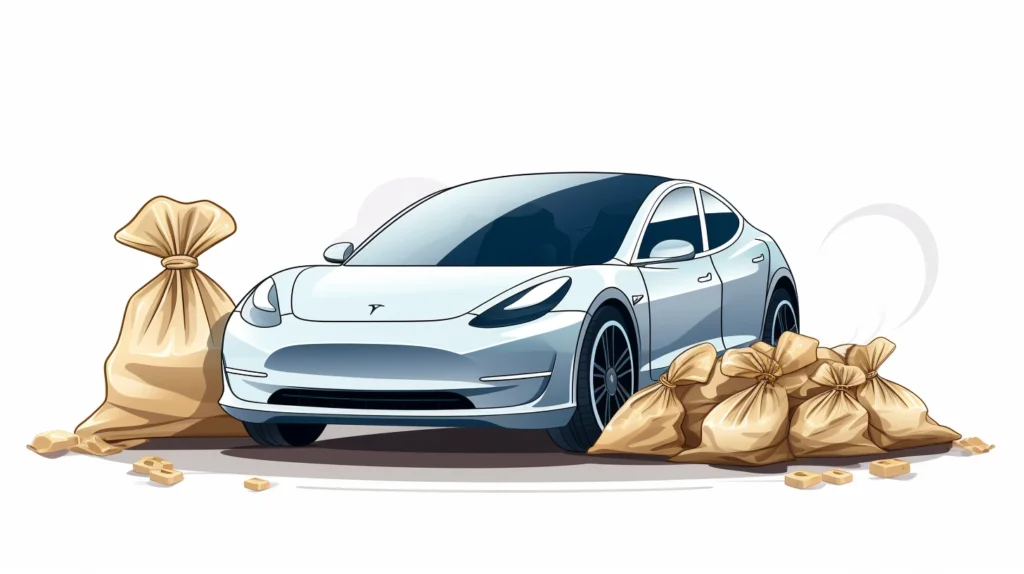In the United States, the mean cost of electric cars reached $66,000 last month – marking an over 13% hike from the previous year. This upward trend may be disappointing for those hoping for more affordable EV options; however, it’s essential to consider the broader context.
One of the most enduring grievances against electric vehicles has been their steep price tags, making them out of reach for most consumers, even with financial incentives in play.
In reality, most new vehicles do not make a wise investment for most individuals, and electric vehicles are targeting the new car sector. However, it’s worth noting that many carmakers venturing into the EV market began with pricier segments, making electric automobiles relatively more expensive on average.

Image credit: caredge
Adding to the already complex situation, rampant inflation is elevating the cost of all goods — electric cars included. A fresh report by Kelley Blue Book that observes average car prices throughout the US confirms that the mean EB price escalated by 13.7% to $66,000.
New EVs’ average price in the U.S.
Before delving into the average price of electric vehicles in the US, let’s explore the extremes of the price spectrum for new EVs:
On the lower end is the 2023 Chevrolet Bolt EV, which holds the title of the cheapest electric car in the country with a starting MSRP of $27,495. Moreover, this model qualifies for Clean Vehicle Credit, potentially reducing its effective price by an additional $7,500. The second most affordable EV is the Nissan Leaf, with an MSRP of $28,040.
Conversely, at the other end of this spectrum lies a true luxury offering—the 2023 Rolls-Royce Spectre. With its Phantom trim priced at an astonishing $460,000 (and remarkably attracting deposits from several hundred buyers), it stands as one of America’s most expensive EVs. While tax breaks may not be readily available to bring down its cost like mainstream options offer.
Although no reasonable and mainstream electric vehicle even comes close to reaching Spectre’s price point, on average, electric vehicle prices tend to hover around 33% higher than those of non-electric cars. It is worth noting that there has been a modest decline of approximately 9% over two years in this premium gap. However, it hasn’t significantly impacted lowering actual purchase costs as desired. In reality, though, it is important to acknowledge that overall vehicle prices have been steadily rising across all segments in recent years.
While progress has been made in narrowing the pricing disparity between electric and non-electric vehicles over time, ongoing efforts are needed to make EVs more accessible and competitive within different market segments.
Average Price for Used EVs in the US
As of early 2023, the average price for used electric vehicles (EVs) in the US stands at approximately $40,700.
While a small but growing percentage of EVs can be found below $25,000, the most affordable used options often include models like the Nissan Leaf or Chevrolet Spark. However, it’s worth noting that older Tesla Model S vehicles may also appear within the price range of $25,000 to $30,000.
On average, for the top ten best-selling EVs on our list, used prices hover around $58,500. Nevertheless, when considering only the least expensive used EVs from each model category collectively, this average drops to about $40,400. Conversely, for those seeking higher-end options with steeper asking prices within these popular models’ ranges,the average rises to approximately $76,600.
Despite relatively high pricing trends observed in today’s used EV market; there are indications suggesting potential changes on the horizon.
Why Are Electric Vehicles So Expensive?
Despite promises from EV manufacturers about increased production leading to lower electric car costs, prices have remained stubbornly high. Even with Tesla producing an impressive 1.37 million EV units last year and established automakers like Ford and Chevrolet ramping up their EV production, the average price of an electric car has increased in recent years. From around $54,700 in early 2020, today’s average electric car price is $64,000. So why haven’t prices leveled out or decreased?
The anticipated key to reducing EV prices was the cost of battery packs, which were expected to reach the ideal threshold of less than $100 per kilowatt hour (kWh) before 2020. However, current battery prices have unfortunately surged to around $152 per kWh.
Over the past several years, a series of unfortunate manufacturing events have plagued the industry—not just EV manufacturers. Disrupted supply chains, shipping challenges, and factory shutdowns due to various factors, including COVID-19 impacts, material shortages, and heightened competition for components, have left everyone scrambling for solutions. Many companies have resorted to offsetting rising material costs by passing them on to consumers through higher vehicle prices.
Simultaneously, gas prices experienced significant increases while demand for EVs skyrocketed. When demand outpaces supply in any market sector—including EVs—prices generally do not decline but continue their upward trajectory. Moreover, some dealerships seized this opportunity by marking up the cost of electric cars well above MSRP due to the high demand for these vehicles that still sold quickly despite sticker shock.
Even on the private market for used EVs, where one might expect more affordability, long lead times for new vehicle production and scarcity of affordable options have kept used EV prices near or even at MSRP levels. Recently, there have been fluctuations thanks to Tesla’s price drops.
Since approximately 2020, EVs have been a seller’s market, but the cost of an electric car in 2023 may begin to trend in the opposite direction. In fact, this shift has already started due to Tesla’s price adjustments, market saturation—especially for popular models like the Tesla Model 3/Y—and other factors at play.
While challenges persist with high prices, for now, there are hopeful signs that indicate a potential change in direction as market dynamics evolve and competition intensifies. Continued technological advancements, improved supply chain resilience, and growing economies of scale should eventually make more affordable electric vehicles accessible to a wider range of consumers.
Will Electric Vehicle Cost Go Down?
The Federal Clean Vehicle Credit eligibility changed recently due to a change in federal law; Tesla responded by implementing significant price reductions. In order to remain competitive with Tesla, other manufacturers may soon follow suit and adjust their prices accordingly. Furthermore, dealership markups that have contributed to inflated EV prices are stabilizing.
Consequently, as new EV prices decrease, sellers of used electric vehicles also adjust their expectations and ask prices. Notably, we are witnessing Model 3 Long Range AWD variants with asking prices below the $30k threshold for the first time.
The possibility of new battery technology for EVs raises intriguing prospects. While a shift in battery components could potentially lead to a more stable supply situation within the industry, it is important to recognize that lithium remains the preferred battery type for most EVs currently available. Bearing this limitation in mind, we may anticipate an increase in smaller-range EV options to achieve more affordable price points than those seen in today’s market.
As part of this potential wave of smaller and more cost-effective EVs, there is speculation surrounding whether Tesla will unveil its long-awaited Model 2 (initially referred to as the $25,000 Tesla). Although information about the Model 2 largely remains speculative at this stage, it holds promise as a potential addition to Tesla’s lineup if it materializes.
These developments indicate an evolving landscape where affordability becomes a key focus within electric mobility—an eagerly awaited trend by consumers seeking accessible and budget-friendly options while transitioning towards sustainable transportation solutions.


